Ever wondered how art brings life to stories from the past? Madhubani art, a treasure from ancient India, does just that! Born in the Mithila region of Bihar, this art form beautifully reflects the bond between humans and nature. Traditionally painted on mud walls by women, Madhubani captures every element of life—nature, gods, festivals, and love.
Over time, it shifted from walls to canvas, spreading its charm worldwide. Using natural dyes and intricate patterns, each painting tells a unique tale, often inspired by mythology or the environment. What makes it special is its simplicity and vibrant colors that immediately draw attention.
Today, Madhubani art is not just a cultural symbol but also a way to preserve nature’s beauty and ancient traditions. Its journey from village homes to international galleries is a story worth exploring.
Let’s dive into this fascinating world and celebrate its timeless appeal!
What is the Origin of Madhubani Art?
Madhubani art has its roots in over 2,500 years. Just behind the stories revolving around Madhubani art itself, its background is no less beautiful and enticing than the painted works.
From the earliest recorded memories in Mithila, in contemporary Bihar, India, to marry Prince Rama, it’s said that as Sita prepared for marriage with Sita, a painting depicting happiness was drawn to commemorate this gaiety event by her father, the great King Janak, when Sita’s marriages were going on.
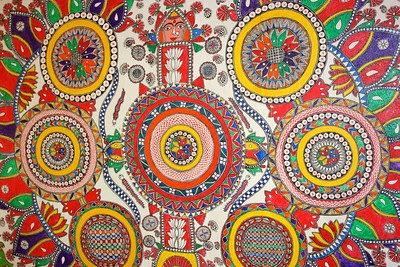
This evolved into what we now call Madhubani or Mithila paintings. Originally, women used to paint on freshly plastered mud walls and floors using natural colors and brushes made from bamboo sticks and rags.
Eventually, artists began working on cloth, handmade paper, and even canvas, but the nature of the art never changed. They kept using colors taken from natural sources, such as turmeric, indigo, and palash flowers, mixed with goat’s milk or gum arabic for painting.
Recognized for its cultural significance, Madhubani paintings even earned a Geographical Indication (GI) status. Today, this art form connects the past to the present, celebrating its timeless beauty worldwide.
Types of Madhubani Art: A Colorful Journey Through Tradition
Well, readers, as now we know that Madhubani art, also referred to as Mithila painting, and this art form has bold lines, geometric patterns, and the use of natural colors.

Now, let’s explore its 6 primary styles i.e. Bharni, Kachni, Tantrik, Godna, Mithila, and Kohbar.
1. Bharni Style: The Art of Filling Colors
Bharni is one of the most vibrant Madhubani styles. Artists use bright, bold colors like red, blue, yellow, and green to fill the outlined patterns. Common themes include Hindu deities, nature, and mythology. Bharni art often carries a spiritual essence, with depictions of gods like Krishna, Durga, and Lakshmi.
Fun Fact: Bharni became famous after the 1960s when women from the Brahmin and Kayastha communities began painting for commercial purposes. Today, this style enjoys global acclaim for its rich and colorful appeal.
2. Kachni Style: A Tale in Fine Lines
Kachni relies on intricate line work instead of bold colors. Artists use fine, detailed patterns to create shading and texture, usually sticking to monochromatic tones like black, red, or green.
Kachni themes include flora, fauna, and folk tales, with every line telling a story of patience and precision.
Did You Know?: This style is often chosen for its minimalist charm and elegant detailing, making it a favorite among art collectors.
3. Tantrik Style: A Spiritual Connection
The Tantrik style of Madhubani art focuses on religious and spiritual themes. It portrays tantric symbols, yantras, and deities like Kali, Shiva, and Saraswati. The paintings often use bold outlines with a mix of subtle and striking colors.
Insight: This style embodies the spiritual essence of Indian culture, connecting art with divine beliefs.
4. Godna Style: The Tattoo-Inspired Art
Godna is inspired by traditional tattoo patterns. Artists use repetitive geometric shapes, floral motifs, and animal figures in simple black and white or earthy tones. This style was initially painted on the skin and later transitioned to cloth and paper.
Statistics: Around 30% of Madhubani artists today are preserving Godna’s legacy, adapting it to modern mediums like apparel and home décor.
5. Mithila Style: The Roots of Tradition
Mithila art is the oldest and most traditional form of Madhubani painting. It combines elements of all styles and often features wedding scenes, daily village life, and rituals. The use of natural dyes and handmade paper makes it sustainable and authentic.
Highlight: Over 60% of rural artists in Bihar still practice Mithila art, keeping this centuries-old tradition alive.
6. Kohbar: A Symbol of Love and Fertility
Kohbar paintings are traditionally made during wedding ceremonies. These artworks represent love, fertility, and prosperity, portraying themes like union, harmony, and divine blessings. Common elements include:
- Lotus flowers and vines: Symbols of fertility and purity.
- Sacred animals and fishes: Signify good luck and marital bliss.
- Deities like Lord Shiva and Parvati: Embody eternal togetherness.
Fun fact: In Kohbar art, bright colors like red, yellow, and green dominate. Artists often use natural dyes derived from turmeric, neem leaves, and flowers, ensuring eco-friendly creations.
The Evolution of Madhubani Art: From Ancient Walls to Global Canvas
This captivating art form, originating in the Mithila region of Bihar, India, has moved from humble beginnings to global recognition, demonstrating remarkable resilience and evolution. Let’s explore its captivating journey.
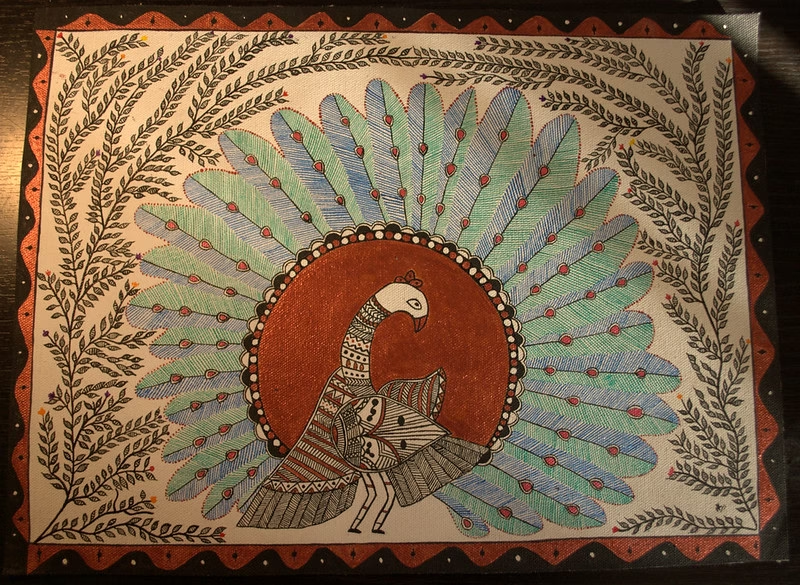
Ancient Roots and Flourishing Traditions
The story begins in the 3rd century BCE. Legend has it that King Janaka commissioned artists to decorate his palace walls for his daughter Sita’s wedding to Lord Rama. This marked the first known instance of Madhubani art. Between the 4th and 12th centuries, the art flourished as local women decorated their homes, employing natural pigments from plants and minerals.
They painted vibrant murals depicting everything from mythology and folklore to nature and daily life. The vibrant colors and intricate designs became a visual language, narrating stories and capturing the essence of their world.
Rediscovery and Economic Revival
For centuries, Madhubani art remained a localized tradition. But its journey took an unexpected turn in 1934. A major earthquake in Bihar exposed these stunning wall paintings, capturing the attention of British colonial officer William G. Archer.
He documented these newly exposed artworks, bringing them international attention and sparking a global intrigue. However, challenges loomed. The 1960s saw severe droughts, which prompted the Indian government to step in and seek the help of women to transfer their skills from walls to paper, as a means of income.
This pivotal moment allowed women artists to preserve their culture and gain financial independence.
Global Stage and Contemporary Innovations
By the 1980s, Madhubani art had firmly established itself on the global stage. Artists like Sita Devi (awarded the Bihar Ratna in 1984), Ganga Devi (recipient of Padma Shri in 1981) and Mahasundari Devi, became prominent figures in the art world, earning international acclaim and prestigious awards. Their work toured the world, further solidifying the art form’s significance.
The 1990s saw contemporary artists embrace innovation, with new themes, techniques, and mediums. They addressed social issues, environmental concerns, and modern narratives while staying true to the traditional motifs.
Organizations and government initiatives actively ensured preservation and promoted Madhubani’s relevance in the modern world.
Statistical Highlights:
- 3rd Century BCE: Origin of Madhubani Art, commissioned by King Janaka.
- 1934: William G. Archer documents Madhubani art, bringing global attention.
- 1960s: Shift from wall to paper as a medium.
- 1981: Ganga Devi receives the Padma Shri.
- 1984: Sita Devi awarded the Bihar Ratna.
- 1995: Establishment of the Mithila Art Institute in Madhubani.
Madhubani art’s journey from ancient walls to global recognition represents a powerful testament to its rich cultural heritage, the resilient spirit of its community, and its enduring artistic power.
Its continuous evolution and consistent adaptation of innovation ensure its captivating stories continue to resonate with art enthusiasts worldwide.
Enchanting Icons: Symbols and Patterns in Madhubani Art
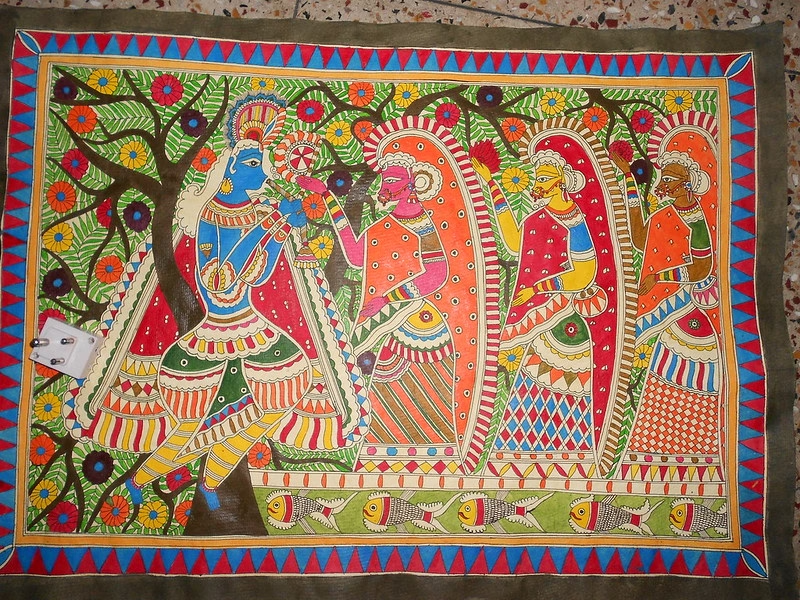
1. Mythological Themes
- Hindu Deities: Central to Madhubani art, deities like Lord Rama, Sita, Krishna, and Ganesha often feature in paintings. Artists portray these divine figures in vibrant hues, reflecting their cultural and spiritual significance.
- Epics and Legends: Scenes from the Ramayana and Mahabharata, such as Sita’s abduction or Krishna’s Rasleela, are common motifs. These narratives immortalize moral values and heroic tales.
2. Nature and Environment
- Flora and Fauna: Artists frequently depict nature, symbolizing life and growth. Common elements include peacocks, fishes, elephants, and flora like lotus and bamboo.
- Tree of Life: A significant motif, the Tree of Life symbolizes creation, protection, and nourishment. Its branches, laden with birds and flowers, often dominate the canvas.
- Peacocks: Representing beauty and grace, peacocks are a recurring theme in Madhubani art. They are often depicted in pairs, symbolizing love and fertility.
3. Social and Cultural Motifs
- Wedding Scenes: Artisans celebrate the union of bride and groom, capturing wedding rituals in their art. These scenes symbolize harmony and prosperity.
- Domestic Life: Scenes of daily life, from women drawing water to farmers in fields, reflect the region’s socio-cultural fabric. These motifs depict the simplicity and richness of rural life.
- Mandalas and Patterns: Geometric patterns like circles and squares, known as mandalas, signify the cosmic connection and continuity of life. Artists use intricate patterns to fill spaces, adding to the artwork’s depth and texture.
4. Symbolic Motifs
- Sun and Moon: Symbols of cosmic power, artists often use the sun and moon to depict eternal time and celestial influence. They are frequently painted with human features, emphasizing their divinity.
- Eyes: Large, expressive eyes symbolize perception and insight. They add an emotional dimension to the figures depicted.
- Tortoise and Serpent: Representing longevity and protection, tortoises and serpents are common protective symbols. They are believed to ward off evil and bring good fortune.
5. Statistical Highlights
- Hindu Deities: Over 70% of Madhubani paintings feature at least one deity.
- Nature Elements: Approximately 60% include flora and fauna.
- Social Scenes: Around 45% of the art depicts social and cultural themes.
Madhubani art weaves a tapestry of symbols and motifs, each carrying profound cultural, spiritual, and social meanings.
The use of intricate patterns, vibrant colors, and symbolic imagery not only enhances the visual appeal but also connects viewers to the rich heritage and traditions of Mithila.
Madhubani’s Maze: Navigating Challenges in a Vibrant Art Form
Madhubani art, so full of bright colors and beautiful designs, has captured hearts all around the world. However, this beautiful art form faces several hurdles in our modern era. Challenges that threaten its very essence as new opportunities emerge.
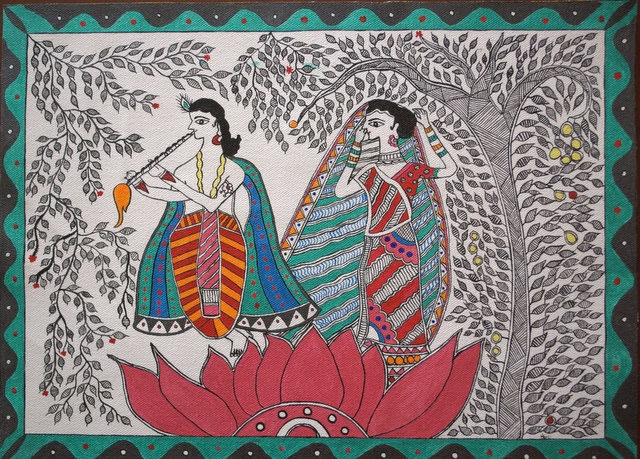
Commercialization and Imitations
- Threat to Authenticity: The lure of quick profit paved the way for mass-produced imitations, undermining the authenticity of genuine Madhubani paintings to a great extent.
- Market Competition: Skilled artists cannot earn a living as they are competing with cheaper, machine-made reproductions that are flooding the market.
- Statistics: In 2023, an alarming 70% of Madhubani paintings sold online were not original but mass-produced reproductions.
Conservation Efforts
- Organizational Support: Non-governmental organizations, cultural institutions, and the Indian government are supporting local artists and promoting authentic Madhubani paintings.
- Government Expedients: The Government of India realized the value of folk arts and in 2024 sanctioned Rs. 50 million for crafts, of which the Madhubani art is also a part.
Digitalization
- Global Markets: Social media and online tools have opened a new vista for Madhubani artists to sell out their products directly to global markets.
- Recent Sales: In the year 2023, nearly 45 per cent of Madhubani artists found an increase in sales because of online revenues.
- Storytelling: Artists can now connect with people from different corners of the world and share their personal stories behind their artwork.
Standardization of Motifs
- Loss of Individuality: To cater a wider audience the art is standardizing its motifs and this undermines the unique character of individual traditional Madhubani paintings.
- Pressure on Artists: Surveys show that 30% of artists feel compelled to follow popular motifs rather than create their signature styles.
Copyright Issues
- Unofficial Reproductions: Digital media has unfortunately made it easier for unauthorized reproductions of Madhubani art to proliferate, affecting the livelihoods of its artists.
- Incidents: In 2024, more than 40% of Madhubani artists reported cases where their artwork was reproduced without permission.
Sustainability of Natural Resources
- Material Shortage: For a traditional Madhubani, there is a deficiency of natural dyes and hand-made paper in the market because of material scarcity.
- Environmental Issue: Environmental degradation and overuse of resources lead to the shortage of critical materials
- Artist Issues: In 2022, the report stated that 25% of artists face a problem in sustainable and reliable availability of materials in their artwork.
Madhubani art faces several challenges such as imitations, standardized motifs, copyright violations, and sustainability issues.
However, ongoing efforts by various organizations and the power of the digital world offer hope for sustaining this culturally significant art form.
It’s a delicate dance between preserving tradition and embracing the modern world, and the future of Madhubani art depends on our ability to find that balance.
The Bottom Lines
Well, readers, we have reached the end of this blog, thiings we have learned – Madhubani art is something vibrant that truly speaks of Indian cultural heritage-it is a celebration of tradition laced with strokes of creativity and tells stories rich in history reflecting its origin: Mithila, where spirituality and nature sprouted it as one of the expressions of storytelling art.
It takes its shape over generations into five recognized styles: Kachni, Bharni, Tantrik, Godna, and Kohbar, so unique in appearance. These kinds of Madhubani art display intricate patterns and natural motifs, often symbolizing life, fertility, and harmony.
Today, this art form continues to captivate the world, blending traditional charm with contemporary relevance. Preserving its essence will ensure that this timeless tradition inspires generations to appreciate the beauty of art intertwined with history.
For further reading on significance of Madhubani Art, you can visit these useful resources:
Check out our Blog Page on Traditional Indian art.

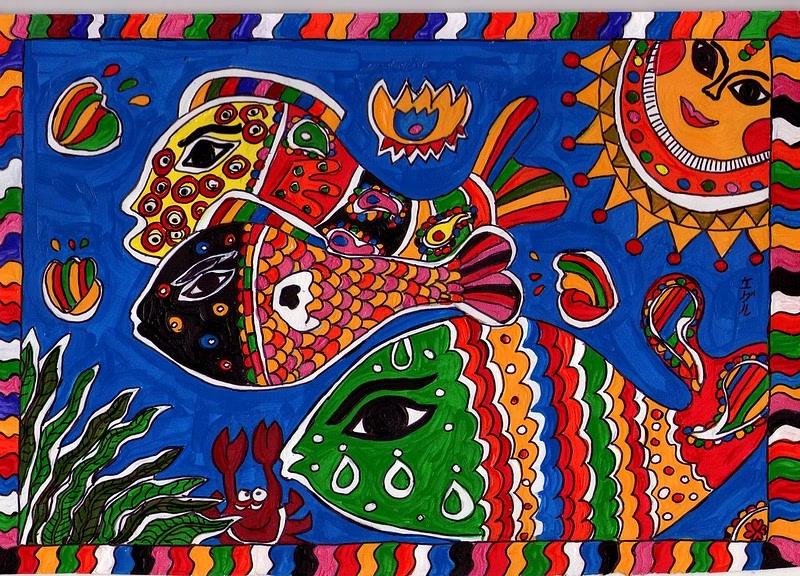
Leave a Reply